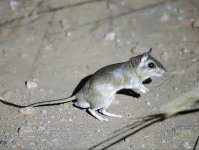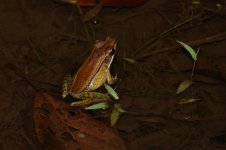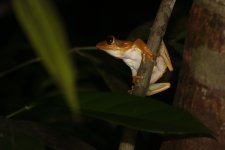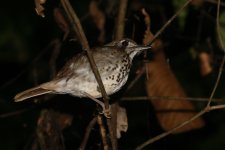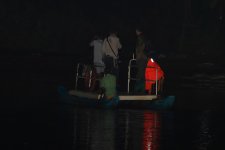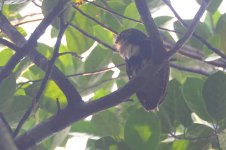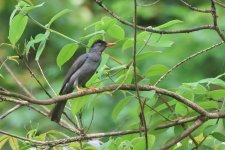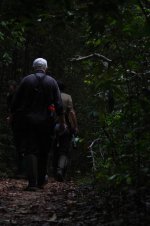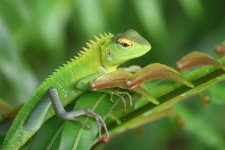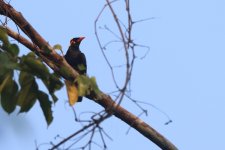-
Welcome to BirdForum, the internet's largest birding community with thousands of members from all over the world. The forums are dedicated to wild birds, birding, binoculars and equipment and all that goes with it.
Please register for an account to take part in the discussions in the forum, post your pictures in the gallery and more.
You are using an out of date browser. It may not display this or other websites correctly.
You should upgrade or use an alternative browser.
You should upgrade or use an alternative browser.
From Dusk Till Dawn (2 Viewers)
- Thread starter Farnboro John
- Start date
More options
Who Replied?Farnboro John
Well-known member
I thought you had, but wow!I had a bit more luck with the gerbil.
John
Steve Babbs
Well-known member
I was able to keep the ISO relatively low for that one: a mere 32,000.I thought you had, but wow!
John
Allen
Well-known member
Wildwings Ladakh trip is reliable for Snow Leopard and they have recently found sites for Pallas Cat on same trip/extensionWell I'm trying to sort us out for snow leopard and Pallas's cat but we will have to give sand cat another bash. I suspect I will just have to accept the lack of rusty-spotted on my cat list.
Steve Babbs
Well-known member
It doesn't fit with my availability and Mongolia appeals a lot more.Wildwings Ladakh trip is reliable for Snow Leopard and they have recently found sites for Pallas Cat on same trip/extension
Farnboro John
Well-known member
And I would freak at the terrain in Ladakh!
John
John
Steve Babbs
Well-known member
We've got an Irish pub to try too. I suggest, if we do get there, a couple of nights before starting to allow a proper night enjoying the novelty of an Irish pub in Mongolia. We need to get a team together first if anyone fancies an adventure. Hopefully with considerably more sleep.And I would freak at the terrain in Ladakh!
John
Last edited:
Farnboro John
Well-known member
Day 8: 10 April
Today was a transit day, moving from Sigirya to Kitulgala, in the upland wet zone. We could expect higher humidity to go with the already high temperatures. For most of the journey we saw only those really obvious species that frequent fields and paddies – ibises, egrets and the odd stork.
We revisited the temple to have a last go for the funky stripey skink but again dipped out. Apparently there had been a Russell’s Viper there earlier but we dipped that too – though once told of its presence I kept a very keen eye out for snakes.
However, not long into the journey we had a planned stop to visit two bat roosts at a single site, for two species we hadn’t yet met. Anticipation was high! The NIFS Popham Arboretum at Dambulla is a small sanctuary set up by a British expat, Mr Popham, who gifted it to the NIFS and now runs it as a reserve with educational and wildlife watching activities. We visited both bat roosts and to our delight one held a single Lesser False Vampire, a really cool-looking bat with long ears and one of those crumpled faces that hold your attention. The other had a colony of Rufous Horseshoe Bats which were also a tick and nice to see but not quite as arresting in looks. To minimise disturbance we took our photos quickly, didn’t linger and moved quietly without conversation. The Lesser False Vampire was my bat of the trip, a real cracker regarding us with a bright intelligent expression that is most likely completely misleading anthropomorphism on my part.
As the journey continued we left the flat lowlands and began to wind up into the hills. Speaking of winding up, steep slopes and long drops often set off my fear of heights, but the roads we took in Sri Lanka were so protected by route, thick woodland and where necessary, substantial barriers, that I had no qualms at all. Having heard me screaming in the past no doubt Steve at least was relieved. I certainly was. I wasn’t so chuffed with various bus drivers driving right onto the back of our minibus and then honking continuously until they got past, often overtaking on blind bends…. I formed the opinion that all Sri Lanka bus drivers are stark raving mad. The drive had been estimated at two and a half hours but heavy traffic associated with the build up towards Sri Lanka’s New Year celebrations turned that into five.
As the evening began to close in suddenly our driver indicated right and turned across the traffic (Sri Lanka drives on the left in case I haven’t mentioned it, maybe that familiarity helps with accepting the driving conditions?) into the entrance driveway of the Kitulgala Rest House, stopping under a canopy that stretched to the wide eaves of the rest house itself – which had a colonial government building look about it but was none the worse for that, solidly built with good ventilation.
Our rooms were allocated and we headed off to them, quickly finding that they were actually below the lobby and dining area, set into the hillside with windows facing out over a lawn beyond which the land dropped steeply for about seventy feet to the river Kelani. Before that we had to negotiate the staircase down to room level which would have been a non-event except for the number of giant honeybees buzzing fairly bad-temperedly in the stair well, with numerous casualties and corpses spread across the actual stairs. Not ideal but we made it without untoward incident.
Once in the room Roy and I had our next invertebrate encounter, this time with a two-inch cockroach shimmying around the edges of first the bathroom and then the living room floor. Roy formed the opinion that they were roosting inside the somewhat broken hollow wooden door. I formed the opinion that I wasn’t putting up with it and tested the saying “hard to kill as a cockroach” with the heel of my discarded trainer. Not so hard then….. A second one went the same way very soon after appearing and happily we saw no more during our stay at the Rest House. I suppose I should have photographed them before hitting them.
Rufous Horseshoe Bat
Lesser False Vampire (bat of the trip for me)
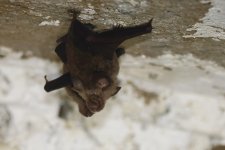
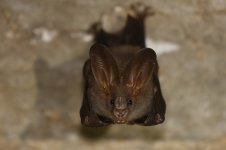
Today was a transit day, moving from Sigirya to Kitulgala, in the upland wet zone. We could expect higher humidity to go with the already high temperatures. For most of the journey we saw only those really obvious species that frequent fields and paddies – ibises, egrets and the odd stork.
We revisited the temple to have a last go for the funky stripey skink but again dipped out. Apparently there had been a Russell’s Viper there earlier but we dipped that too – though once told of its presence I kept a very keen eye out for snakes.
However, not long into the journey we had a planned stop to visit two bat roosts at a single site, for two species we hadn’t yet met. Anticipation was high! The NIFS Popham Arboretum at Dambulla is a small sanctuary set up by a British expat, Mr Popham, who gifted it to the NIFS and now runs it as a reserve with educational and wildlife watching activities. We visited both bat roosts and to our delight one held a single Lesser False Vampire, a really cool-looking bat with long ears and one of those crumpled faces that hold your attention. The other had a colony of Rufous Horseshoe Bats which were also a tick and nice to see but not quite as arresting in looks. To minimise disturbance we took our photos quickly, didn’t linger and moved quietly without conversation. The Lesser False Vampire was my bat of the trip, a real cracker regarding us with a bright intelligent expression that is most likely completely misleading anthropomorphism on my part.
As the journey continued we left the flat lowlands and began to wind up into the hills. Speaking of winding up, steep slopes and long drops often set off my fear of heights, but the roads we took in Sri Lanka were so protected by route, thick woodland and where necessary, substantial barriers, that I had no qualms at all. Having heard me screaming in the past no doubt Steve at least was relieved. I certainly was. I wasn’t so chuffed with various bus drivers driving right onto the back of our minibus and then honking continuously until they got past, often overtaking on blind bends…. I formed the opinion that all Sri Lanka bus drivers are stark raving mad. The drive had been estimated at two and a half hours but heavy traffic associated with the build up towards Sri Lanka’s New Year celebrations turned that into five.
As the evening began to close in suddenly our driver indicated right and turned across the traffic (Sri Lanka drives on the left in case I haven’t mentioned it, maybe that familiarity helps with accepting the driving conditions?) into the entrance driveway of the Kitulgala Rest House, stopping under a canopy that stretched to the wide eaves of the rest house itself – which had a colonial government building look about it but was none the worse for that, solidly built with good ventilation.
Our rooms were allocated and we headed off to them, quickly finding that they were actually below the lobby and dining area, set into the hillside with windows facing out over a lawn beyond which the land dropped steeply for about seventy feet to the river Kelani. Before that we had to negotiate the staircase down to room level which would have been a non-event except for the number of giant honeybees buzzing fairly bad-temperedly in the stair well, with numerous casualties and corpses spread across the actual stairs. Not ideal but we made it without untoward incident.
Once in the room Roy and I had our next invertebrate encounter, this time with a two-inch cockroach shimmying around the edges of first the bathroom and then the living room floor. Roy formed the opinion that they were roosting inside the somewhat broken hollow wooden door. I formed the opinion that I wasn’t putting up with it and tested the saying “hard to kill as a cockroach” with the heel of my discarded trainer. Not so hard then….. A second one went the same way very soon after appearing and happily we saw no more during our stay at the Rest House. I suppose I should have photographed them before hitting them.
Rufous Horseshoe Bat
Lesser False Vampire (bat of the trip for me)


Farnboro John
Well-known member
We dined on a new variant of chicken curry and rice before sorting out our gear for a night walk in the rainforest. Oh yes. New site, new game: we had to take a small man-powered ferry across the river for a venture into proper jungle. On foot. At night. We were issued leech socks and advice to spray a ring of heavily DEET-laden insect repellent round them to keep leeches at bay. Thanks to the leech socks – long stemmed foot shapes of ripstock nylon with laces at the top, intended to be tied firmly above the bulge of calf muscles and indeed so worn by all members of the party except me – being non-stretch, they wouldn’t go over my Conan-like calves: so instead of looking an elegant expedition-ready male model I set out with a crumpled mess of nylon not far above my ankles. They were very heavily soaked in DEET though!
The ferry was a pair of small plastic canoes bolted in catamaran fashion to an aluminium deck with handrails. The ferryman sat in the stern of one of the canoes with a paddle and propelled us across the fairly substantial river. Bats skimmed the surface just like Daubenton’s back home: Dulan said these would be Brown Bats (Myotis hasseltii) whose habits are just as described. Not knowing whether Muggers lurked in the river I leapt promptly up the steps away from it before pausing to look around. Above us the concrete track led steeply up the hillside towards the lights of a village: back across the river were the welcome lights of home. Dulan led us off up the hill and the climate began to bite.
It was so humid there was a hint of mist: just about enough to be a promise of it rather than the thing itself. The temperature seemed to have barely dropped from daytime. Within a few yards we were sweating and before the path levelled just a little, I at least was wringing wet right through. Even my t-shirt was so wet that it could not absorb more: wiping my forehead with my hand (mainly to prevent insect repellent slipping down into my eyes) I then couldn’t wipe it dry again on that or any other part of my clothing.
We spent the next several hours searching the jungle for owls, night mammal targets and herps. We couldn’t get any wetter and most of the time we were at least on tracks rather than in virgin forest – though once in a while we had to move off the path to see something located by light or thermal imager. Now and again Dulan would ask us to turn our lights off and wait in darkness for sound or sign of something. When the lights were on we could see, every time we stopped, dozens of leeches looping their way across the forest floor towards us from all directions. Not being able to even see them created near frenzy when the lights came back on, with queries of “anything on me where I can’t see?” and suchlike. Once I caught the tip of my foot on a low branch we were stepping over and crashed to the ground, twisting as usual to keep my optics safe. I’d no means of knowing what I was falling onto and I’ve never come back up so quickly from a fall, then dusting my hands together to knock off any undesirable wildlife and swishing torch around to check for larger game like snakes before a quick leech check from earth-blackened knees downwards….
With my interest in military history and the Chindit field commander John Masters as one of my personal heroes I was fascinated to experience even in a mild way this Asian rainforest. How in hell’s name could Chindits move in total darkness: not on trails, having to cut their way through thick jungle, no torches, no thermal imagers to see what’s out there, just total darkness and a column of men to bang into, branches to fall over, snakes, scorpions, spiders (we found some real corkers including a huge hairy bird-eating spider sp with a leg spread of over ten inches) elephants and so on – plus of course somewhere the Japanese looking for them…. The thing is quite impossible. My admiration for those soldiers rose several new notches with new understanding, there’s all the difference in the world between reading about it and trying it.
Anyway, we did also actually see some really great wildlife, and if I couldn’t understand how Chindits could move and fight in the jungle I had no idea whatsoever how Dulan kept track of where he was and memorised routes to and positions of particular trees so he could tell us to stop and confidently say this was a spot for flying squirrel, palm civet, whatever…. But so he did, and we had a Travancore Flying Squirrel (the smaller of the two species in Sri Lanka) sitting up high in the canopy peering down at us from its transverse perch on a branch.
Herp of the night was a Sri Lanka Wolf Snake which was however one of those irritating individuals that won’t give you a good look at its head. The amount of variation among the frogs and toads, and for that matter lizards, was amazing. Neither have previously been my thing but we saw so many different species that I found them very interesting. Lizards that gave themselves up during the walk were the familiar Green Forest Lizard plus a couple of ticks: Sri Lankan Kangaroo Lizard and Whistling Lizard.
As for amphibians, they were everywhere: roosting on leaves, on tree branches, on rocks, in pools and streams, making their way across damp ground. A few names from this walk: Asian Common Toad, Hollow-snouted Shrub Frog, Gunther’s Golden-backed Tree Frog, Kelaart’s Dwarf Toad, Kotagama’s Dwarf Toad, Sri Lanka Wood Frog. Some of them looked ordinary, but some were very colourful and almost elegant. Former princes?
Late in the walk Dulan proposed a side route up to another of his favourite spots. I don’t think we scored there but we did find a roosting Spot-winged Thrush on a branch that was a tick and an interesting photo subject in the deep forest night. On the homeward leg we had an Asian Palm Civet in a palm tree by the village. We heard but didn’t see Serendib Scops Owl, discovered some years previously by Dulan’s colleague Deepal. No ticks on call I’m afraid.
Back at the river we were surprised to find that the level had fallen quite a lot. It appears the level is subject to the demands of a hydro-electricity project upstream that stores water when “nobody needs it” – overnight – and releases it for power at peak times during the day. As a result the river was now so shallow we had to be ferried over in two batches. Steve and Big John went first and I took the chance to photograph the ferry in action at night while Roy and I waited our turn.
Back in the room Roy and I stripped off and checked each other for leeches. I’d got away with it but Roy had been had and the offending beast was curled up (not attached) in his navel. It came to a sticky end shortly after discovery. I’d seen earlier that Steve had also suffered and had a huge bloody patch on the back of his shirt, between the shoulderblades.
Hollow-snouted Shrub Frog
Bird-eating Spider sp
Whistling Lizard
Gunther's Golden-backed Tree Frog
Sri Lanka Flying Squirrel (The smaller of the two flying squirrels. Photo taken vertically upwards.)
Kotagama's Dwarf Toad
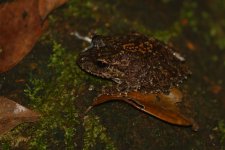
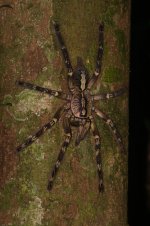
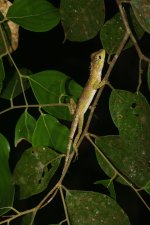
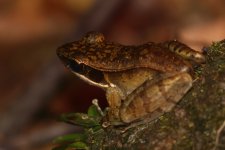
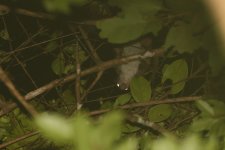
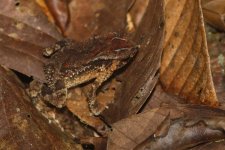
The ferry was a pair of small plastic canoes bolted in catamaran fashion to an aluminium deck with handrails. The ferryman sat in the stern of one of the canoes with a paddle and propelled us across the fairly substantial river. Bats skimmed the surface just like Daubenton’s back home: Dulan said these would be Brown Bats (Myotis hasseltii) whose habits are just as described. Not knowing whether Muggers lurked in the river I leapt promptly up the steps away from it before pausing to look around. Above us the concrete track led steeply up the hillside towards the lights of a village: back across the river were the welcome lights of home. Dulan led us off up the hill and the climate began to bite.
It was so humid there was a hint of mist: just about enough to be a promise of it rather than the thing itself. The temperature seemed to have barely dropped from daytime. Within a few yards we were sweating and before the path levelled just a little, I at least was wringing wet right through. Even my t-shirt was so wet that it could not absorb more: wiping my forehead with my hand (mainly to prevent insect repellent slipping down into my eyes) I then couldn’t wipe it dry again on that or any other part of my clothing.
We spent the next several hours searching the jungle for owls, night mammal targets and herps. We couldn’t get any wetter and most of the time we were at least on tracks rather than in virgin forest – though once in a while we had to move off the path to see something located by light or thermal imager. Now and again Dulan would ask us to turn our lights off and wait in darkness for sound or sign of something. When the lights were on we could see, every time we stopped, dozens of leeches looping their way across the forest floor towards us from all directions. Not being able to even see them created near frenzy when the lights came back on, with queries of “anything on me where I can’t see?” and suchlike. Once I caught the tip of my foot on a low branch we were stepping over and crashed to the ground, twisting as usual to keep my optics safe. I’d no means of knowing what I was falling onto and I’ve never come back up so quickly from a fall, then dusting my hands together to knock off any undesirable wildlife and swishing torch around to check for larger game like snakes before a quick leech check from earth-blackened knees downwards….
With my interest in military history and the Chindit field commander John Masters as one of my personal heroes I was fascinated to experience even in a mild way this Asian rainforest. How in hell’s name could Chindits move in total darkness: not on trails, having to cut their way through thick jungle, no torches, no thermal imagers to see what’s out there, just total darkness and a column of men to bang into, branches to fall over, snakes, scorpions, spiders (we found some real corkers including a huge hairy bird-eating spider sp with a leg spread of over ten inches) elephants and so on – plus of course somewhere the Japanese looking for them…. The thing is quite impossible. My admiration for those soldiers rose several new notches with new understanding, there’s all the difference in the world between reading about it and trying it.
Anyway, we did also actually see some really great wildlife, and if I couldn’t understand how Chindits could move and fight in the jungle I had no idea whatsoever how Dulan kept track of where he was and memorised routes to and positions of particular trees so he could tell us to stop and confidently say this was a spot for flying squirrel, palm civet, whatever…. But so he did, and we had a Travancore Flying Squirrel (the smaller of the two species in Sri Lanka) sitting up high in the canopy peering down at us from its transverse perch on a branch.
Herp of the night was a Sri Lanka Wolf Snake which was however one of those irritating individuals that won’t give you a good look at its head. The amount of variation among the frogs and toads, and for that matter lizards, was amazing. Neither have previously been my thing but we saw so many different species that I found them very interesting. Lizards that gave themselves up during the walk were the familiar Green Forest Lizard plus a couple of ticks: Sri Lankan Kangaroo Lizard and Whistling Lizard.
As for amphibians, they were everywhere: roosting on leaves, on tree branches, on rocks, in pools and streams, making their way across damp ground. A few names from this walk: Asian Common Toad, Hollow-snouted Shrub Frog, Gunther’s Golden-backed Tree Frog, Kelaart’s Dwarf Toad, Kotagama’s Dwarf Toad, Sri Lanka Wood Frog. Some of them looked ordinary, but some were very colourful and almost elegant. Former princes?
Late in the walk Dulan proposed a side route up to another of his favourite spots. I don’t think we scored there but we did find a roosting Spot-winged Thrush on a branch that was a tick and an interesting photo subject in the deep forest night. On the homeward leg we had an Asian Palm Civet in a palm tree by the village. We heard but didn’t see Serendib Scops Owl, discovered some years previously by Dulan’s colleague Deepal. No ticks on call I’m afraid.
Back at the river we were surprised to find that the level had fallen quite a lot. It appears the level is subject to the demands of a hydro-electricity project upstream that stores water when “nobody needs it” – overnight – and releases it for power at peak times during the day. As a result the river was now so shallow we had to be ferried over in two batches. Steve and Big John went first and I took the chance to photograph the ferry in action at night while Roy and I waited our turn.
Back in the room Roy and I stripped off and checked each other for leeches. I’d got away with it but Roy had been had and the offending beast was curled up (not attached) in his navel. It came to a sticky end shortly after discovery. I’d seen earlier that Steve had also suffered and had a huge bloody patch on the back of his shirt, between the shoulderblades.
Hollow-snouted Shrub Frog
Bird-eating Spider sp
Whistling Lizard
Gunther's Golden-backed Tree Frog
Sri Lanka Flying Squirrel (The smaller of the two flying squirrels. Photo taken vertically upwards.)
Kotagama's Dwarf Toad






Farnboro John
Well-known member
If really that large, perhaps something interestingtwo-inch cockroach shimmying around
“hard to kill as a cockroach” with the heel of my discarded trainer. Not so hard then…..
Only if not a common pest like Periplaneta (likewise, please only kill in those circumstances)I suppose I should have photographed them before hitting them.
One amazing spider. I remember the leeches there with "fondness": one reason to stick to the Neotropics!
Allen
Well-known member
Thankfully I don't struggle with heights (albeit one particular Ladakh snow covered, mountainside 'track' in a minibus was a squeaky bum moment and had me picturing the headline 'Birders plummet to death searching for Snow Leopard'). But a 10" span arachnid would freak me out completely!
Farnboro John
Well-known member
"it is true what Hathi the Wild Elephant says: “To each his own fear” - Baloo, teacher of the Seeonee wolf-pack, quoted by Rudyard Kipling in "Kaa's Hunting".Thankfully I don't struggle with heights (albeit one particular Ladakh snow covered, mountainside 'track' in a minibus was a squeaky bum moment and had me picturing the headline 'Birders plummet to death searching for Snow Leopard'). But a 10" span arachnid would freak me out completely!
John
Steve Babbs
Well-known member
I must have had hundreds of leech bites in the past: unpleasant but no big-deal. These sods have only just stopped itching.One amazing spider. I remember the leeches there with "fondness": one reason to stick to the Neotropics!
In class I keep getting hands going up: "Mr Babbs you're bleeding."
It's the itching more than anything. Since it's an immune reaction it varies for each person. I've had leech and mosquito bites that have itched for more than 6 months...I must have had hundreds of leech bites in the past: unpleasant but no big-deal. These sods have only just stopped itching.
In class I keep getting hands going up: "Mr Babbs you're bleeding."
Steve Babbs
Well-known member
I've had it with mosquitos a lot and once had a tick bite that would flare up for a year but I don't think I've had it with leach bites. Mind you a lot of my time in Asia was in the 90's so maybe it's my memory playing up.It's the itching more than anything. Since it's an immune reaction it varies for each person. I've had leech and mosquito bites that have itched for more than 6 months...
Farnboro John
Well-known member
Day 9: 11 April
Not an early start, rather a leisurely one sorting out gear, in particular counting shirts against days to do, especially since here every time we went out we were going to get soaking wet with sweat…. Also a chance to sit out on the veranda and watch the river, now babbling cheerfully with water level restored to what it had been when we arrived. Just sitting, not moving about and getting sweaty, seemed a great idea but there were a few birds about and I did prowl the lawn a couple of times, not to much effect. I got more from scanning the river with bins, spotting two large swimming reptiles with tails swishing back and forth as they swam… not Muggers but big Water Monitors, perhaps five feet long or so. It seemed one was encroaching on the other’s territory because there was a definite chase in progress with the one behind very much pursuing the other and at one point taking a sprint short cut across a sandbank. It drove off the interloper and then returned to bask on the far bank for a while.
Nearer to me an immature White-bellied Sea Eagle appeared seemingly from nowhere quite low and I fired off a sequence of pictures as it flapped heavily past me. Brilliant – the first two we saw were miles away. Little Cormorants were fishing in the river and occasionally hauling out on the rocks that stuck up from the water in various places.
After lunch we had our first jungle walk of the day. Across the ferry in daylight (a pair of adult White-breasted Water-hens were a nice bonus in the backwater next to the ferry landing on the Rest House side of the river, and I got some pictures of the Little Cormorants) and off up the hill to the village, where we had a conducted tour of all the spots where Dulan thought we might find our target squirrel. We didn’t, but we did add Chestnut-backed Owlet, Layard’s Parakeet, Yellow-browed Bulbul, Square-tailed (Black) Bulbul and Crested Drongo to the trip and tick lists. Some of them even sat for photos, though branches kept getting in the way and some were straight up with the light behind them. If I think of more excuses I’ll deploy them! We then made our way to a paddy cleared out of the woods, above which a Lesser Hill Myna was singing from the top of a tree.
Dulan left us at the edge of the paddy while he went to search the woodland beyond it and eventually he returned in high excitement: he’d found a Serendib Scops Owl roosting in a thick bush and would take us in one at a time to see it. This, a recently discovered species as I think I’ve already said, was pretty much at the top of our bird target list (yes, I know it’s a mammal trip) and we were in a fever of anticipation as we followed him to the neighbourhood of the roost site. Each in turn we accompanied Dulan into the woods and were pointed at where the small owl sat quietly among broad leaves in a very dark bush indeed. I ran into real trouble with the electronic viewfinder and could hardly see the bird let alone focus and shoot at it (I should mention I could see it just fine with my bins). Dulan went back in with my camera after everyone had seen it and somehow managed to make it take something I could turn into a record shot. But wow what a bird. The illustration in the Sri Lanka guide really does not do it justice, barely showing what are really prominent feather horns on its head or its intensely chestnut plumage. Fantastic! When we left it was still roosting quietly, unworried by our visit.
Getting a massive target like that takes a lot of pressure off and it was a relieved and happy crew that returned to the Rest House to have dinner and prepare for another night walk in the forest – in fact the last effort of the Bird and Wildlife Team part of our tour and consequently a sign that our time was coming to an end. We all felt this to an extent: the tour had been hard work but by thunder it had delivered, and we were once again heading for discomfort and possible blood-letting with considerable optimism that we might manage one more big score before relaxing into our last couple of days in Sri Lanka.
Water Monitor
White-bellied Sea Eagle
White-breasted Waterhen
Little Cormorant
River Kelani (quite a lot of the exterior shots for Bridge on the River Kwai were done on this river, not far from our gaff.)
Little Cormorant
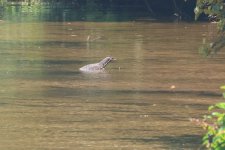
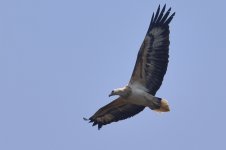
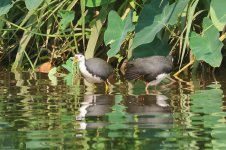
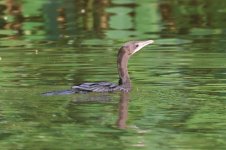
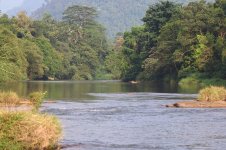
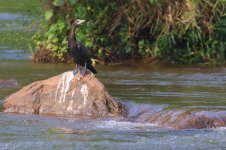
Not an early start, rather a leisurely one sorting out gear, in particular counting shirts against days to do, especially since here every time we went out we were going to get soaking wet with sweat…. Also a chance to sit out on the veranda and watch the river, now babbling cheerfully with water level restored to what it had been when we arrived. Just sitting, not moving about and getting sweaty, seemed a great idea but there were a few birds about and I did prowl the lawn a couple of times, not to much effect. I got more from scanning the river with bins, spotting two large swimming reptiles with tails swishing back and forth as they swam… not Muggers but big Water Monitors, perhaps five feet long or so. It seemed one was encroaching on the other’s territory because there was a definite chase in progress with the one behind very much pursuing the other and at one point taking a sprint short cut across a sandbank. It drove off the interloper and then returned to bask on the far bank for a while.
Nearer to me an immature White-bellied Sea Eagle appeared seemingly from nowhere quite low and I fired off a sequence of pictures as it flapped heavily past me. Brilliant – the first two we saw were miles away. Little Cormorants were fishing in the river and occasionally hauling out on the rocks that stuck up from the water in various places.
After lunch we had our first jungle walk of the day. Across the ferry in daylight (a pair of adult White-breasted Water-hens were a nice bonus in the backwater next to the ferry landing on the Rest House side of the river, and I got some pictures of the Little Cormorants) and off up the hill to the village, where we had a conducted tour of all the spots where Dulan thought we might find our target squirrel. We didn’t, but we did add Chestnut-backed Owlet, Layard’s Parakeet, Yellow-browed Bulbul, Square-tailed (Black) Bulbul and Crested Drongo to the trip and tick lists. Some of them even sat for photos, though branches kept getting in the way and some were straight up with the light behind them. If I think of more excuses I’ll deploy them! We then made our way to a paddy cleared out of the woods, above which a Lesser Hill Myna was singing from the top of a tree.
Dulan left us at the edge of the paddy while he went to search the woodland beyond it and eventually he returned in high excitement: he’d found a Serendib Scops Owl roosting in a thick bush and would take us in one at a time to see it. This, a recently discovered species as I think I’ve already said, was pretty much at the top of our bird target list (yes, I know it’s a mammal trip) and we were in a fever of anticipation as we followed him to the neighbourhood of the roost site. Each in turn we accompanied Dulan into the woods and were pointed at where the small owl sat quietly among broad leaves in a very dark bush indeed. I ran into real trouble with the electronic viewfinder and could hardly see the bird let alone focus and shoot at it (I should mention I could see it just fine with my bins). Dulan went back in with my camera after everyone had seen it and somehow managed to make it take something I could turn into a record shot. But wow what a bird. The illustration in the Sri Lanka guide really does not do it justice, barely showing what are really prominent feather horns on its head or its intensely chestnut plumage. Fantastic! When we left it was still roosting quietly, unworried by our visit.
Getting a massive target like that takes a lot of pressure off and it was a relieved and happy crew that returned to the Rest House to have dinner and prepare for another night walk in the forest – in fact the last effort of the Bird and Wildlife Team part of our tour and consequently a sign that our time was coming to an end. We all felt this to an extent: the tour had been hard work but by thunder it had delivered, and we were once again heading for discomfort and possible blood-letting with considerable optimism that we might manage one more big score before relaxing into our last couple of days in Sri Lanka.
Water Monitor
White-bellied Sea Eagle
White-breasted Waterhen
Little Cormorant
River Kelani (quite a lot of the exterior shots for Bridge on the River Kwai were done on this river, not far from our gaff.)
Little Cormorant






Farnboro John
Well-known member
MKinHK
Mike Kilburn

Delighted to come back to this excellent thread after a week-long gap.
Not so thrilled to be royally gripped by your superb Fishing Cats shots. They crapped by the pool where I stayed in Sigiriya but that was as close as I got!
And very disappointed there are no pix of leeched-up blood-bespattered birders!
Cheers
Mike
Not so thrilled to be royally gripped by your superb Fishing Cats shots. They crapped by the pool where I stayed in Sigiriya but that was as close as I got!
And very disappointed there are no pix of leeched-up blood-bespattered birders!
Cheers
Mike
Users who are viewing this thread
Total: 3 (members: 0, guests: 3)




